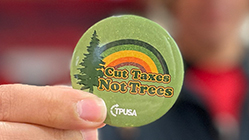How To Best Prepare For President Biden’s Warning of a Food Shortage
I’ll be honest, I did not have President Biden casually saying we should expect food shortages in America on my 2022 bingo card, but here we are:
This statement by the president of the United States of America is preposterous, but this is what you can expect when weak men are put in charge of the country.
Here’s the problem for America’s younger generations: regarding long-term solutions, getting prepared for moments like this can be a challenge. I understand it’s completely impracticable to tell young people to go buy a farm, build a chicken coop, start a victory garden, store water, etc.
College students and young professionals aren’t exactly in the best situation to build self-reliance away from supply chains that could begin to break.
Whether you are still in school and living in a dorm, or live in a small apartment in an urban area with little space, or maybe you’d love to buy a home one day with a yard but simply don’t have the budget yet: that’s okay.
To be honest, if this issue of food shortages isn’t just short-term, then a completely new discussion needs to be had. For now, I’m here to help you with advice to be better prepared for a short-term emergency situation like a potential food shortage:
First, I’ll share a story. When the major winter storm hit Texas in early 2021, Texas was not ready. Power was out in huge patches. There was no snow equipment and no ice for the roads, so the ditches were lined with cars sliding off the road with just one or two inches of snow. Massive accidents were happening all over the place, and it got so bad that highways were literally shut down.
What did that lead to? The grocery stores couldn’t be restocked because it was impossible for the restock trucks to travel. In just a couple days, the grocery store shelves were nearly empty. The situation was completely unexpected.
For the unprepared people of Texas, including myself, we were left with whatever food we already had in our pantries. For my 24-year-old self in my apartment, let’s just say my pantry wasn’t very stocked up. Luckily I had some frozen cases of breakfast sausage in the freezer and a full bag of rice in the pantry because, after a couple days, that was literally all I had left to eat.
I learned my lesson, and that’s what I want to share with you today: slow preparedness for young Americans with limited capability.
Let’s flash forward to today: the shelves are looking emptier by the day, and now our president is warning of actual food shortages.
Given the grim warning from our president, it’s okay to feel uneasy about your circumstances. To get yourself in a better position, I highly recommend the following:
- Do not rely on panic-buying at the last minute. Waiting for a crisis to start before collecting items in bulk not only worsens shortages but it’s also irresponsible and too risky. Instead of panic buying in bulk after reading a freaky headline, every time I go to the grocery store, I always budget a small amount to buy items that will go straight to my stockpile.
- Buy healthy and practical food items that last. I have a collection of flour, protein-packed pasta, canned vegetables and fruits, canned soup with meat, ramen noodle cups, nutrient-dense granola and power bars, lard, yeast for making bread, salt, dry powder meals that require adding water, etc., stocked in my pantry.
- Buy water. Depending on how much space you have, store gallons of water. During the ice storm in Texas, many families’ pipes froze, leaving them stuck without flowing water for days. Water is not only important for thirst but also for your hygiene!
- Build a collection of hygiene and health-related items. In case the shortages and supply chain issues lead to a lack of hygiene and medical items, make sure you have basics in your bathroom cabinet like Neosporin, cortisone, toothpaste, a first aid kit, soap, etc.
- Build a stash of vitamins. Just in case you find yourself in a situation like I was in back in the Texas winter storm, your diet won’t be ideal. In my stash, I keep a couple jars of women’s daily vitamins, Emergen-C drink mix with Vitamin C, and packages of electrolyte drink mixes.
Now, with all that being said, please keep in mind these are not suggestions for long-term solutions. Long-term, you need to be thinking about how to build a more self-reliant lifestyle for yourself and your family. But for potential short-term issues, these action items will help.
As you grow into adulthood, I hope news stories like this encourage you to actively work to become more self-reliant. Until that day comes when those larger goals become more possible for you, consider implementing my slow-growth stockpile technique to be better prepared for these uneasy times caused by weak leaders.
While I hope you never need to tap into this stockpile, it’s always better to have it just in case!


















